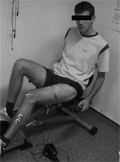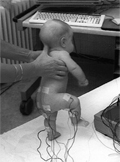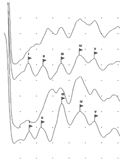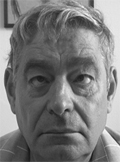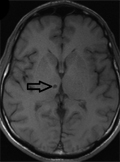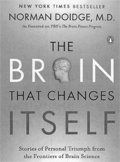The eLitMed.hu medical portal uses computer cookies for convenient operation. Detailed information can be found in the Cookie-policy.
Clinical Neuroscience - 2011;64(07-08)
Content
[Recent changes in the paradigm of limbic encephalitis]
[In the recent years, novel antibodies associated with limbic encephalitis have been described, which target such extracellular receptors or proteins that have been already indicated in the pathogenesis of hereditary or degenerative diseases. In a number of cases, where pathogenic role of antibodies generated against the voltage-gated potassium channel (VGKC) had been presumed, antibodies against a trans-synaptic scaffolding protein, LGI1 were indicated. Antibody response against NMDA-receptors has been suggested as a major cause of limbic encephalitis especially in young females, resulting in a typical clinical syndrome sometimes triggered by an ovarian teratoma. Antibodies against other receptors essential in synaptic transmission and plasticity (AMPA and GABAB receptors) have been also indicated, partially elicited by paraneoplastic processes. Such antibodies against surface proteins result in severe but potentially treatable diseases due to reversible internalization of the antigens crosslinked by the bivalent antibodies. In contrast, the rare classical onconeural antibodies reacting with intracellular targets (anti-Hu, anti-Ta/Ma2, anti- CV2/CRMP5) may elicit additional symptoms beside limbic encephalitis and the prognosis of such syndromes is poor.]
[Modeling of human movements, neuroprostheses]
[Modeling of human movements became very important as modern methods in informatics and engeniering are available to discern human movement characteristics that were hidden before. The construction of models of neural control and mechanical execution of human movements helps the diagnosis of movement disorders and predicts the outcome of clinical intervention and medical rehabilitation. Here I present methods for recording kinematic and muscle activity patterns. Measurements can be compared with predicted movement patterns based on mathematical models. There are an infinity of different muscle activity patterns or joint rotation patterns to perform a given motor task. I present the main approaches that are used to find such solutions from the infinity of choices that might be employed by the central nervous system. I present a practical application of movement modeling: In rehabilitation of spinal cord injured patients we develop and apply artificially controlled neuroprostheses to generate active cycling lower limb movements in the patients of the National Institute for Medical Rehabilitation.]
[Extension of polynomial analysis of interstitial I-125 brachytherapy for 48 months]
[Objective - Previously we described from 20 patients’ data with our new “polynomial prediction approach” the volumetrical changes following gliomas I-125 brachytherapy. The aim of this study is to extend the polynomials for 48 months, and to carry out multivarial analysis of several different aspects. Methods - 20 inoperable low-grade gliomas were followed for a 48-month period after I-125 interstitial irradiation. The delivered dose on the tumor surface was 50-60 Gy. Dose planning and image fusion were done with the BrainLab Target 1.19 software, mathematical and statistical computations were carried out with the Matlab numeric computation and visualization software. Volumes of tumor necrosis, reactive zone and edema referred to as “triple ring” were measured on image fused control MRI and planning CT images. The measured volumes were normalized with respect to the reference volumes. Mean values of volumes were determined, then polynomials were fitted to the mean using the polynomial curve fitting method. The accuracy of our results was verified by correlating the predicted data with the measured ones. Results - We have found that the edema reaches its maximum two times after irradiation during the 48 months follow up period. We have shown that small tumors react more rapidly and creating greater volumes of the “triple ring” than bigger ones. Conclusions - The polynomial prediction approach proposed here reveals the dynamics of triple ring for 48 months. The derived polynomials and the multivarial analysis carried out afterwords help to (i) design the best treatment, (ii) follow up the patient's condition and (iii) plan reirradiation if necessary.]
[Phylo- and ontogenetic aspects of erect posture and walking in developmental neurology]
[The group or profile of elementary neuromotor patterns is different from the primitive reflex group which is now called the “primitive reflex profile.” All these elementary neuromotor patterns are characterized by a high degree of organization, persistence, and stereotypy. In many regards, these patterns are predecessors or precursors of from them the specific human motor patterns which appear spontaneously later as crawling, creeping, sitting, and walking with erect posture. On the basis of our experiences it can be stated that the elementary neuromotor patterns can be activated in all neonates and young infants as congenital motor functions. With regards to their main properties and functional forms, the normal patterns can be divided into two main groups: (1) One group is characterized by lifting of the head and complex chains of movements which are directed to the verticalization of the body; (2) The other group is characterized by complex movements directed to locomotion and change of body position. The neuromotor patterns can be activated by placing the human infant in specific body positions that trigger the vestibulospinal and the reticulospinal systems, the archicerebellum and the basal gangliae. Most of these systems display early myelinisation and are functioning very soon. Many of the elementary neuromotor patterns reflect the most important - spontaneously developing - forms of human movements such as sitting upright in space and head elevation crawling and walking. The majority of the human neuromotor patterns are human specific. When the infant is put in an activating position, crawling, sitting up, and walking begin and last as long as the activating position is maintained. Each elementary neuromotor pattern is a repeated, continuous train of complex movements in response to a special activating position. The brainstem is not sufficient to organize these complex movements, the integrity of the basal ganglia is also necessary. Elementary sensorimotor patterns during human ontogenesis reflect phylogenetic develpoment of species specific human functions. During ontogenesis spontaneous motor development gradually arises from these early specific sensorimotor predecessors.. The regular use of the elementary neuromotor patterns for diagnostic puposes has several distinct advantages. The neuromotor patterns have a natural stereotypy in normal infants and, therefore, deflections from this regular pattern may be detected easily, thus, the activation of the elementary neuromotor pattern is a more suitable method for identifying defects in the motor activity of the neonate or young infant than the assessment of the primitive reflexes. The “stiumulus positions,” which activate specific movements according to how the human neonate or young infant is positioned, do not activate such motor patterns in neonate or young primates including apes. The characteristic locomotor pattern in these adult primates, including the apes, is swinging and involves brachiation with an extreme prehensility. This species specific motor activity is reflected in the orangutan and gibbon neonates by an early extensive grasp. However, according to our investigations, no crawling, creeping, elementary walk, or sitting up can be activated in them. Neonates grasp the hair of the mother, a vital function for the survival of the young. In contemporary nonhuman primates including apes, the neonate brain is more mature. Thus, pronounced differences can be observed between early motor ontogenesis in the human and all other primates. The earliest human movements are complex performances rather than simple reflexes. The distinction between primitive reflexes and elementary neuromotor patterns is essential. Primitive reflexes are controlled by the brainstem. All can be activated in primates. These reflexes have short durations and contrary to elementary sensorimotor patterns occur only once in response to one stimulus, e.g., one head drop elicits one abduction-adduction of the upper extremities correlated to adduction and flexion of the lower extremities to a lesser degree with the Moro reflex. Elementary neuromotor patterns are much more complex and most of them including elementary walk may be elicited as early as the 19th-20th gestational week, though less perfectly than later.]
[Combined evoked potentials in co-occuring attention deficit hyperactivity disorder and epilepsy]
[Background and purpose - Evoked potentials, both stimulus related and event related, show disturbances in attention deficit-hyperactivity disorder and epilepsies, too. This study was designed to evaluate if these potentials are characteristically influenced by the presence of the two diseases, individually, and in the case of co-occurrence. Methods - Fourty children were included, and four groups were formed, control group, ADHD group, epilepsy group and a group with the comorbidity of epilepsy and ADHD. Epilepsy patients were under proper antiepileptic treatment; ADHD patients were free of specific therapy. Brainstem auditory evoked potentials, visual evoked potentials and auditory P300 evaluation were performed. Results - The latency of the P100 and N135 visual evoked potential components was significantly extended by the presence of epilepsy. If ADHD was concomitantly present, this effect was attenuated. Brainstem auditory evoked potential components were prolonged in the presence of the comorbidity, considering the waves elicited in the brainstem. P300 latencies were prolonged by the presence of co-occurring ADHD and epilepsy. Feedback parameters showed overall reduction of the tested cognitive performances in the ADHD group. Conclusion - Disturbances produced by the presence of ADHD-epilepsy comorbidity reveal hypothetically a linked physiopathological path for both diseases, and offers an approach with possible diagnostic importance, combined evoked potential recordings.]
[Initial clinical experience with radio-frequency assisted percutaneous vertebral augmentation in the treatment of vertebral compression fractures]
[Purpose - Percutaenous Vertebroplasty (PVP) is effective in alleviating pain and facilitating early mobilization following vertebral compression fractures. The relatively high risk of extravertebral leakage due to uncontrolled delivery of low viscosity bone cement is an inherent limitation of the technique. The aim of this research is to investigate the ability of controlled cement delivery in decreasing the rate of such complications by applying radiofrequency heating to regulate cement viscosity. Method and material - Thirty two vetebrae were treated in 28 patients as part of an Ethics Committee approved multicenter clinical trial using RadioFreqency assisted Percutaenous Vertebral Augmentation (RF-PVA) technique. This technique is injecting low viscosity polymethylmethacrylate (PMMA) bone cement using a pressure controlled hydraulic pump and applying radiofrequency heating to increase cement viscosity prior to entering the vertebral body. All patients were screened for any cement leakage by X-ray and CT scan. The intensity of pain was recorded on a Visual Analog Scale (VAS) and the level of physical activiy on the Oswestry Disability Index (ODI) prior to, one day, one month and three months following procedure. Results - All procedures were technically successful. There were no clinical complication, intraspinal or intraforaminal cement leakage. In nine cases (29%) a small amount of PMMA entered the intervertebral space through the broken end plate. Intensity of pain by VAS was reduced from a mean of 7.0 to 2.5 and physical inactivity dropped on the ODI from 52% to 23% three months following treatment. Conclusion - In this small series controlled cement injection using RF-PVA was capable of preventing clinically hazardous extravertebral cement leakage while achieving outcomes similar to that of conventional vertebroplasty.]
[Pseudo abducens palsy]
[In this study, we present two cases of different eye movement disorders with variable case histories but with the same end stage; abduction paresis of one of the eyes, which ceased when the other eye was covered. Our differential diagnosis is that either the ocular form of myasthenia gravis, convergence spasm or ocular myotonia could explain the symptoms. However, we hypothesize that the clinical picture corresponds to pseudo abducens palsy or focal dystonia of the extraocular muscle, which in turn could be the result of impaired inhibition of the tonic resting activity of the antagonistic medial rectus muscle. We offer an explanation for the patomechanism of pseudoabducens palsy and the variants of internuclear ophthalmoplegia.]
[Treatment of wide necked intracranial aneursyms in staged procedure with stent implantation and coils]
[Since the introduction of electrolytically detachable coils the endovascular treatment of intracranial aneurysms is dynamically developing. The good results with this technique led to a progressive expansion of the indications. For the treatment of complex, wide-necked and fusiform aneurysms several new devices and techniques were developed. The introduction of a new device is possible after a feasibility study. In these studies the number of cases is low. Some risk factors or possible complications occur only after the introduction of a new device to the market.]
[Unilateral ptosis associated with paramedian thalamic infarction]
[The paramedian artery arises from P1 segment of posterior cerebral artery and supplies a variable extent of thalamus but usually the dorsomedian, median, internal medullary lamina and the intralaminar nuclei. The typical clinical picture of unilateral paramedian thalamic infarctions consist of arousal and memory disorders, language or visuospatial disorders depending on the side of the lesion accompanied with gaze palsies and sensory-motor deficits. Ipsilateral ptosis associated with paramedian thalamic infarctions has been rarely reported. We report a 31 years old patient presenting with unilateral ptosis and right sided facial numbness associated with right paramedian thalamic infarction.]
[Criticism to neurological services and suggestions for improving it based on the article of Dániel Bereczki and András Ajtay]
[Criticism to neurological services and suggestions for improving it based on the article of Dániel Bereczki and András Ajtay 2011;64(07-08)]
1.
Clinical Neuroscience
[Headache registry in Szeged: Experiences regarding to migraine patients]2.
Clinical Neuroscience
[The new target population of stroke awareness campaign: Kindergarten students ]3.
Clinical Neuroscience
Is there any difference in mortality rates of atrial fibrillation detected before or after ischemic stroke?4.
Clinical Neuroscience
Factors influencing the level of stigma in Parkinson’s disease in western Turkey5.
Clinical Neuroscience
[The effects of demographic and clinical factors on the severity of poststroke aphasia]1.
2.
3.
4.
5.





